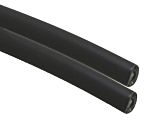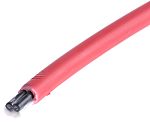|
|
What is a fibre optic cable?
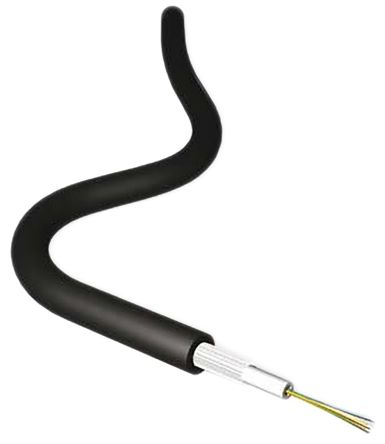
Fibre optic cable is an advanced type of network cable, offering significantly improved performance in terms of bandwidth and data carrying than traditional metal conductor versions.
Optical fibre cabling is used to transfer information via pulses of light, which pass along one or more - indeed, anything up to a couple of hundred in some cases - transparent glass or plastic pipes. Each of these strands is little wider than an average hair, and will normally be surrounded by a further layer of cladding (also in glass or plastic, but constructed at a different density to the main inner strand).
Wrapped around the cladded fibres, there’s also a sheath made up of a couple of layers of insulated casing. This usually comprises a protective wrapper, known as a buffer tube, followed by a final outer jacketing designed to protect the multi-stranded cable as a whole.
How do fibre optic cables work?
In understanding how data is sent through fibre optic cables, it’s important to note that there are multiple components involved in the construction of an optical fibre that are all required to ensure they work properly. Obviously, the glass strands themselves are absolutely central to the system working at all - but there are also a number of other key parts that all play a role in successful data transfer along optical fibres.
Firstly, there needs to be a source of light to send information ‘pulses’ along the strands of transparent glass or plastic tubing at the core of the cable. This is usually created either by a tiny laser or by an LED source, which receives an input signal coming from transmitter circuitry and converts it to a light pulse before bouncing it along the fibre cores.
Secondly, it’s key that the glass fibres themselves are surrounded by an additional glass or plastic cladding layer, which will have a different refractive index for light passing through it than the core strands. These refractive differences between the cladding and the glass fibres it surrounds are what allow the incoming light pulses to be bent at particular angles as it travels the length of the cable.
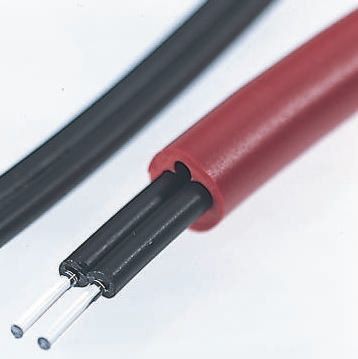
The light pulses are confined within the transparent parts of the fibre cable thanks to its internal reflective properties, moving in a zig-zagging pattern to pass around bends as they travel along the full run length of the fibre optics. In order to retain sufficient signal strength throughout particularly long cable runs, they may need to be converted to an electrical signal and back to a light pulse again at various points along the way. This is done by additional internal components known as repeaters.
When the light signals eventually reach their intended destination - having been travelling at around 70% the speed of light for most of the way - they can finally be interpreted as data or communication signals and converted to an output by the receiving equipment.
What are fibre optic cables made of?
As noted above, fibre optic cables are constructed from numerous materials and components - but the core strands themselves are usually made from some combination of glass (silica) and/or plastic.
Plastic optical fibres tend to be more economical and easier to work with due to their increased flexibility, lighter weight and resistance to bending and shock. They’re generally used for applications where lower transmission rates and speeds are acceptable, and where the risk of mechanical stress is lower - such as in lower-speed, shorter-distance runs as part of home, industrial or automotive networks.
We’ll discuss the particular characteristics of the higher-grade silica glass cables a little further on in this guide.
Advantages of optical fibre cables
As previously noted, fibre optic cabling has a number of key characteristics that give it a clear advantage over traditional metal conductor cables in several important criteria. These include:
-
-
-
Bandwidth and data transfer - Older metal data cables, usually copper, offer relatively limited bandwidth compared to fibre optics. Copper-type communication cabling was originally developed to transmit voice signals, which don’t require nearly as much bandwidth for mass data transfer as many modern applications now demand.
-
Speed - Using light pulses as the primary source of information conveyance gives fibre optic cables a huge speed advantage when compared to other modes of data transfer. Fibre will generally far outstrip the expected performance of even high-grade (Cat5 or Cat6) copper cables in this regard.
-
Distance - As well as being lightning fast, fibre optic cables can also carry their signals over much longer distances than traditional cabling types due to their low rate of signal power loss. Copper cables are usually cited as having a 328-foot limitation in terms of decent quality transfer distance; by contrast, certain single fibre optics can carry a signal over hundreds of kilometres given the right combination of materials, signal type (wavelength) and network setup.
-
Interference - Fibre optics provide significantly greater protection from interference than traditional metal cable types, because they don’t physically carry an electrical signal. This further boosts their ability to transfer data quickly over much longer distances without suffering significant signal degradation.
-
Safety and reliability - Another difference between optical fibre and copper cable is that the glass versions tend to be much thinner, lighter and yet sturdier, making them able to withstand much greater pull forces and thus less likely to suffer damage or breakage across long runs than equivalent lengths of metal cabling. Fibre isn’t affected by inclement weather, moisture or extremes of temperature to nearly the same extent that metal wiring can be - and furthermore, the fact that glass fibres don’t carry a current means they don’t present a fire hazard even when damaged or ageing.
-
-
Characteristics of fibre optic cables
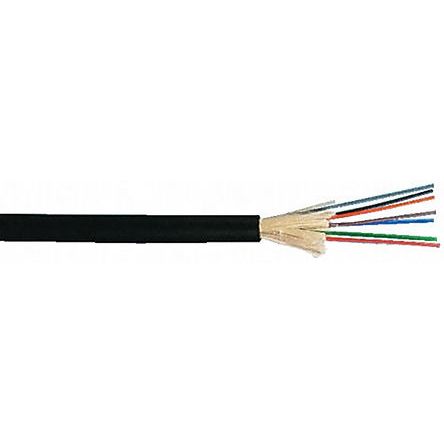 As with any such product or component, there are a number of important characteristics and classifications of optical fibre cabling that will directly affect its efficacy and efficiency in terms of bandwidth, speed, signal strength and more. In this section, we’ll look a little more closely at some of the main influencing factors and properties that might dictate the overall performance of any given fibre optic cable.
As with any such product or component, there are a number of important characteristics and classifications of optical fibre cabling that will directly affect its efficacy and efficiency in terms of bandwidth, speed, signal strength and more. In this section, we’ll look a little more closely at some of the main influencing factors and properties that might dictate the overall performance of any given fibre optic cable.Transmission speed of fibre optic cables
Fibre optic data transfer rates will generally be reliant on various factors, chief among them being the ‘mode’ of the cable. As we’ll see in a moment, optical fibres can be arranged either in single mode or multimode configurations, and these will typically deliver higher or lower speeds over a set range of distances.
Regardless of whether you’re using single mode or multimode cable though, fibre optic still offers essentially the fastest mode of commercial-grade network connectivity and communications data transfer available today.
Research into developing new types of optical fibre that exceed current conventional limits on bandwidth and transfer speed over ever-increasing distances is continually ongoing. In 2018, NICT Network System Research Institute and Fujikura Ltd went public as having developed ‘a 3-mode optical fiber, capable of wide-band wavelength multiplexing transmission with standard outer diameter (0.125 mm) that can be cabled with existing equipment’.
These researchers were able to demonstrate astonishing transfer rates of 159 terabits per second over a cable length of 1045 km, which - according to phys.org - made it the current ‘world record in a standard outer diameter few-mode optical fibre and the largest data rate over 1000 km for any kind of standard-diameter [cable]’.
Single mode vs multimode fibre optic cables
Single mode and multimode optical fibres are two different types of cable configuration which deliver varying potential performance levels at distance.
As the names suggest, single mode fibre optic cables are built around a single strand of glass fibre with a relatively narrow diameter, while multimode cables are built around larger cores that guide many modes simultaneously.
Single mode fibre involves much less internal reflection as light passes along it, which in turn reduces attenuation and allows for much higher speed data transfer over long distances. By contrast, multimode fibre cabling dramatically increases the amount of reflection, which in turn causes higher dispersion and attenuation rates, and thus increases bandwidth delivery over shorter distances.
Single mode is therefore typically used for extremely long-distance signal transmission, while applications requiring a larger volume of data to be sent over a shorter run (such as communications data within or between relatively localised buildings) tend to use multimode fibre optic cabling.
Multicore fibre optic cables
Multimode or multi-core fibre comes in a variety of specifications, ranging anywhere from two to dozens of cores. Common 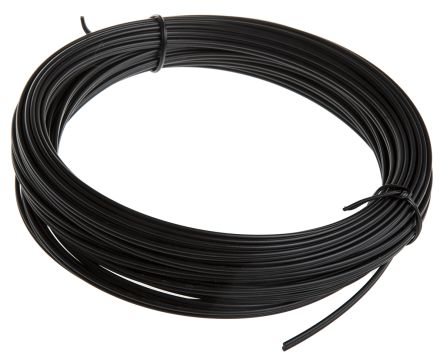 configurations for everyday networking uses such as workplace comms infrastructure include 2-core fibre optic cable, 8-core options and even 24-core varieties. In short, the more cores a cable carries, the greater the amount of bandwidth potential and thus increased ability to handle higher data throughput over shorter distances.
configurations for everyday networking uses such as workplace comms infrastructure include 2-core fibre optic cable, 8-core options and even 24-core varieties. In short, the more cores a cable carries, the greater the amount of bandwidth potential and thus increased ability to handle higher data throughput over shorter distances.
Glass fibre optic cable
Glass optical fibre is more delicate in terms of flex and bend than plastic varieties, and more prone to damage if required to loop tightly or continually be moved around over the length of its run. It can’t be cut, spliced or repaired, meaning it’s less well-suited to applications where a high degree of user flexibility is required.
However, glass fibre optic cables are very robust in terms of mechanical strength and general resistance to moisture, chemical attack, temperature fluctuation and other hostile environments, making it ideal for long-range uses where cables are typically buried or submerged. It’s a particularly versatile type of fibre optic cable with many varying configurations, adapters and fittings available in today’s market.
Glass fibre is most commonly used in very demanding or long-distance applications - tends to be more expensive to buy and install than cheaper-to-produce plastic varieties, while the latter are usually more flexible and easier to work with for the majority of non-specialist installations.
What are fibre optic cables used for?
Fibre optic cables are commonly found today in higher-end internet, phone and TV applications. They’re also used in many other areas of the home and workplace use, including in decor applications - fibre optic Christmas trees, for example, are not at all uncommon now.
The ability of optical fibre cable to save a great deal of space over bulkier types of traditional cabling has also made them a popular choice for numerous lighting and safety features in modern cars. They’re widely used in many other demanding professional fields too, including in a great many medical applications, for detailed mechanical inspections, and as sensors for monitoring and controlling the flow of various sorts of electrical currents, sounds and chemicals.
Medical applications of optical fibre cables |
Common fibre applications in the medical field today include biomedical sensing apparatus for multi-point and multi-parameter detections; optical fibres in endoscopes serving as both imaging and illumination components; and to drive technical advancements in minimally invasive surgical procedures - examples of the latter include the use of short, extremely fine ‘uncabled’ fibers that can be inserted directly into a wide range of hypodermic needles, catheters and other devices. |
Fibre optic cables for internet |
Fibre optic bandwidth is usually significantly higher than what you’d expect to get from a typical ethernet connection. Fibre is also safe to use in high-voltage locations, and in areas where flammable gases or other harsh chemicals or weather conditions are likely to be a factor. Particularly for business uses in demanding environments, this can be another important factor in choosing fibre optic cables for broadband delivery as opposed to standard ethernet. |
Fibre optic cables for televisions |
All of these factors combined means that fibre optics are actually much more cost-effective in the long-run for the TV infrastructure companies, as the day-to-day maintenance expense of fibre after initial installation is typically so much lower than with traditional copper wires. In addition, the customer enjoys a far superior end product with much improved reliability, leading to improved relations and reputations across the sector. Much of the above is also true of fibre optic phone lines, which goes a long way to explaining why so many companies today are continuing to roll out fibre upgrades as widely as possible across their networks, while offering customer incentives for packaging both TV and telephone fibre optic bundles together. |
Fibre optic cables for automobiles |
Unsurprisingly, automotive fibre optics are playing a lead role in pushing innovation and enhancement across many of these areas: demand for quality in-vehicle digital infotainment systems is now extremely high, and these can produce very heavy data loads that traditional copper wire would struggle to transmit especially smoothly, quickly or reliably around the driver and their passengers throughout the cabin. As we’ve already discussed in the sections above, fibre optic cabling is perfectly placed to meet these sorts of automotive challenges head-on - not only is it lightweight and space-saving, but it transfers these high data rates quickly from point A to point B, while being extremely resistant to challenging environments and offering fantastic immunity to interference. These factors also make fibre optics a great choice for all manner of lighting, diagnostics and other safety-critical features that require the reliable transfer of signals and data between transmitters, receivers and displays located anywhere within the vehicle. |
Fibre optic cables for LED lighting |
More importantly, fiber optic LED lighting uses much less electricity than standard bulb options, making it both environmentally friendly and economical. Today, you can buy fibre optic lighting that’s safe in use in an especially wide variety of both home and workplace applications and environments, because it doesn’t carry electrical current and is far more resistant to general wear, damage and degradation. |
Fibre optic cables for sensors |
The cable will in turn connect to a remote sensor or amplifier which emits, receives, and converts the pulses of light energy sent via the cable into an electrical signal. One of the key advantages here is that fibre optic cables can be routed into areas that are too cramped or too hostile for the actual sensor components themselves. Fibre optic sensors are used in a number of different applications. In mechanical properties testing, fibre optical sensors are used to measure mechanical strain. They can also be used to measure acceleration, velocity, pressure, temperature and displacement. Fibre optic cables for sensing currentsFibre optic current sensors work on the basis of the Faraday effect, measuring polarisation rotation as a light source passes through a magnetic field under electrical current induction. Higher currents will generate larger magnetic fields and increased polarisation rotation. A fibre optic current sensor offers reduced electrical interference while performing readings, as it’s not physically attached in any way to the voltage line, there is minimal electrical interference on the signal line, meaning readings are much quicker and more precise. They’re also safer in long-term use, as this lack of direct connectivity means there isn’t a risk of violent explosion in the event of a catastrophic failure. Fibre optic cables for sensing pressureFibre optic pressure sensors again offer extremely accurate and swift measurement, and are ideal for all manner of laboratory and industrial environments and applications. They’re much more robust in harsh or demanding environments than many other types of sensor equipment, and their small size means they can be located in optimal positions that may be out of reach of larger components (or at least require expensive modifications to equipment housing, etc). This enables fibre optic pressure sensors to operate continually in hazardous settings featuring extremes of temperature, moisture, chemical exposure and other challenges. |
Summary
As with all types of wire and cabling - particularly data and communications cable - there’s a vast range of choice when it comes to picking out the ideal type of optical fibre for your intended uses and environments.
Construction materials and core configurations will all play an important role in defining which type of product is best for your needs, as they’ll directly influence factors such as data transfer speeds, bandwidth, reliability and longevity in myriad different applications. You’ll also need to be mindful of connector types, cable diameter and more.
For further information on fibre optic cable technologies in general, or to discuss the potential applications of any specific product, please feel free to contact our expert support team for advice and assistance.
Use one of the links below to view the out top brands for Fibre Optic Cables on the RS website

